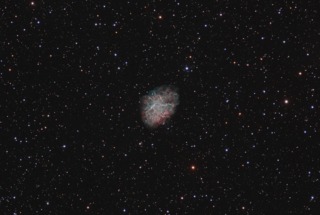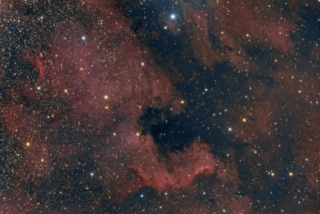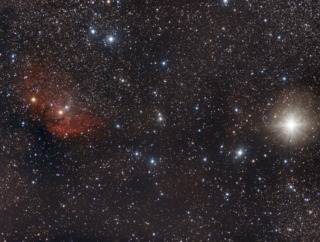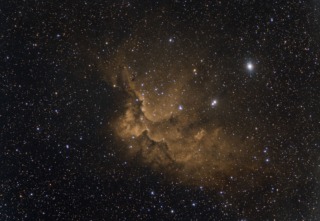
- Constellation: Taurus
- Right Ascension: 05h 34m 31.94s
- Declination: +22° 00′ 52.2″
- Distance: 6,500 ly
Messier 1 or the Crab Nebula, a supernova remnant from a star that went supernova in 1054 observed and recorded by Chinese astronomers. Being so bright, it was even visible in the day time. All that remains of the star is a neutron star that spins at 30 times a second that emits pulses of radiation. Such stars are called pulsars as the beam from their magnetic poles causes a pulse of radiation as they rotate. The expanding nebula is illuminated by the radiation outpouring from the pulsar and is expanding at the rate of 1,500 km/s.
- Details
- Category: Nebulas
- Telescope: Explore Scientific 127 Refractor
- Camera: ZWO 1600 MM

- Constellation: Cepheus
- Right Ascension: 00h 01m 08.58s
- Declination: +67° 25′ 17.0″
- Distance: 2,900 ly
Image of part of an young emission nebula that spans 40 light years across located in Cepheus. The cluster is mostly illuminated by a star named BD+66, one of the hottest stars at 100,000 times more luminous than our sun. A young stellar nursery that is forming new stars from the clouds of dust and gas.
- Details
- Category: Nebulas
- Telescope: Explore Scientific 127 Refractor
- Camera: ZWO 1600 MM

- Constellation: Cygnus
- Right Ascension: 20h 59m 17.1s
- Declination: +44° 31′ 44″
- Distance: 2,590 ly
NGC 7000 North American Nebula a large emission nebula located in Cygnus. The nebula resembles a map of North America, with the dark lower center being the Gulf of Mexico, Mexico located in lower part of the image stretching around to Florida. The nebula and the joining Pelican Nebula in the top right are ionized by a hot O type star in the center.
- Details
- Category: Nebulas
- Telescope: EDT 80mm Reftactor
- Camera: ZWO A071 Color

- Constellation: Cygnus
Random objects, with emission nebula Sh 2-101, aka the Tulip Nebula on the left, blue super-giant star HD226868 and its unseen black hole companion Cygnus X-1 center (lower) bright star, and shining brilliantly the multiple star system Eta Cygni on the right.
- Details
- Category: Nebulas
- Telescope: Explore Scientific 127 Refractor
- Camera: ZWO 1600 MM

- Constellation: Cepheus
- Right Ascension: 22h 47.0m
- Declination: 58° 06′
- Distance: 7,200 ly
NGC 7380 or often called the Wizard Nebula is a open cluster and nebula located in Cepheus. Difficult to see visually, this image is enhanced with Ha and SIII narrow band filters.
- Details
- Category: Nebulas
- Telescope: Explore Scientific 127 Refractor
- Camera: ZWO 1600 MM

- Constellation: Cepheus
- Right Ascension: 21h 42m 56s
- Declination: +66° 6′ 12″
- Distance: 3,300 ly
NGC 7129 is a reflection nebula located in Cepheus. Light reflecting off the surrounding dust and gas from young hot new stars gives a bluish glow. The cluster consists of around 130 stars and is estimated to be around 1 million years old.
- Details
- Category: Nebulas
- Telescope: Explore Scientific 127 Refractor
- Camera: ZWO 1600 MM